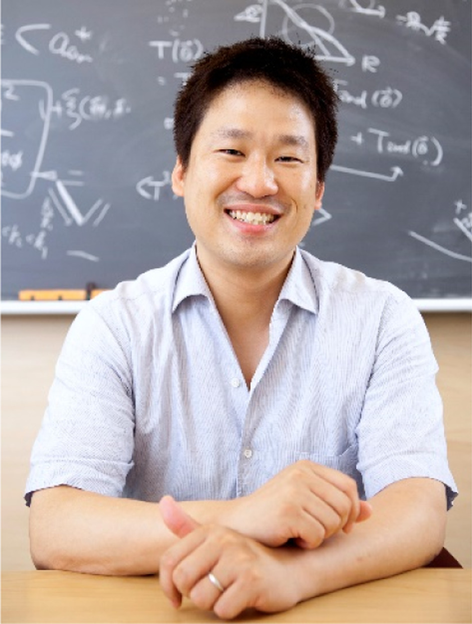Data Availability
Not applicable.
Vol.33 (Feb) 2023 | Article no.6-3 2023

Dr. Eiji Saitoh
Professor, Graduate School of Engineering, University of Tokyo
The charge of an electron and its flow, the electric current, have always been the main physical quantities of interest in electronics. The angular momentum, or the spin, is another fundamental physical quantity of an electron that generates magnetic moment through its polarization and plays an important role in the physics of magnetism and related engineering. Spintronics has emerged as a research field that seeks to discover novel physical phenomena and functionalities through the control of spins, within which the flow of spins, or the spin current, has attracted particular interest.
The spins of conduction electrons in a conductor usually point either upward or downward in a 50–50 ratio, and thus, the spin transfer associated with the flow of electrons is averaged out to zero. The balance between the up- and down-spin flows can be changed to yield a net spin current, e.g., by the flow of spin-polarized electrons in magnetic materials and by the “spin Hall effect,” in which, due to spin–orbit interaction in the material, electrons are subject to a force perpendicular to the current’s direction depending on their spin orientations. However, a direct method for measuring the spin current with an external probe was elusive, and experiments were limited to indirect estimation, e.g., through the observation of “spin accumulation” generated at the sample’s edge by the spin current.
Dr. Saitoh discovered the “inverse spin Hall effect” in 2006 as a scheme for the direct measurement of spin current [11]. He used a bilayer metal film of platinum (Pt) and ferromagnetic alloy, permalloy (Ni81Fe19). When spin excitations were generated in the permalloy layer through ferromagnetic resonance and injected into the Pt probe layer through the interface, the spin current was converted into electric current due to the strong spin–orbit interaction in Pt, and a voltage signal was detected between the two ends of the Pt layer along the direction perpendicular to the magnetic field. This enabled the direct measurement of the spin current for the first time and led to the substantial development of related research.
Since then, Dr. Saitoh and his colleagues have discovered various physical phenomena involving spin currents by using this spin-current detection technique mentioned above. A major achievement among them is the “spin Seebeck effect,” in which a spin current is generated by a temperature gradient applied to a magnetic material and is injected into a probe electrode, e.g., made from Pt, to produce a voltage through the inverse spin Hall effect [12]. In conventional thermoelectric devices based on the Seebeck effect, two different conductors are combined in parallel under a thermal gradient, and the voltage is generated from the difference in the density of states and scattering properties of the conduction carriers in each conductor. The clever idea that led to the discovery of the spin Seebeck effect was to utilize the difference in the behavior of the two spin states of electrons in a single magnetic material.
Dr. Saitoh and his collaborators then extended the physics of spin current from conductors to insulators. They showed that the spin current, as a flow of angular momentum in solids, is carried not only by conduction electrons but also by spin excitations in insulators, a finding that greatly expanded the concept of spintronics. In ferromagnetic insulating oxides such as yttrium iron garnet (YIG), spin waves, which are collective excitation modes of ordered spins of localized electrons, or magnons as their elementary excitations, propagate over long distances without being scattered by conduction electrons. In their 2010 paper, Dr. Saitoh et al. reported that they injected a spin current into a YIG thin film by using the spin Hall effect in a Pt electrode and observed the propagation of the spin current using the inverse spin Hall effect in another Pt electrode [13]. This also revealed that angular momentum is transferred between conduction electrons in the metal electrodes and spin excitations in the insulator through the exchange interaction at the interface. Dr. Saitoh et al. also observed the spin Seebeck effect in YIG-related oxides [14], pioneering research on thermoelectric devices using insulating materials. In addition, they experimentally demonstrated that spin currents are carried not only by magnons in ferromagnets but also by various elementary excitations in solids, such as magnons in antiferromagnets, spinons in quantum spin liquids [15], magnons in nuclear spin wave modes [16], and magnetic polarons, coupled excitations of magnons and phonons. These achievements revealed the broad potential of spin current as a probe for the study of the physical properties of materials.

Dr. Eiichiro Komatsu
Director, Max Planck Institute for Astrophysics
As a theory that explains the global homogeneity and isotropy of the universe, inflationary cosmology, which postulates that the universe experienced exponential accelerated expansion long before primordial nucleosynthesis, is a very attractive idea. However, in order to establish it as the standard cosmology, it is important not only to explain such qualitative observational facts but also to quantitatively verify its predictions. These include that the universe is spatially flat, has an almost scale-invariant spectrum originating from quantum fluctuations, and generates adiabatic curvature fluctuations and tensor fluctuations (quantum gravitational waves) that approximately follow Gaussian statistics.
Dr. Komatsu, under the advice of Professor Spergel at Princeton University, focused on the statistical nature of fluctuations and developed a methodology to quantitatively evaluate the deviation from the Gaussian distribution using cosmic microwave background radiation. While Gaussian distributions can be characterized only by their amplitude and variance, non-Gaussian distributions have infinite possibilities, making it difficult to quantitatively evaluate deviations from a Gaussian distribution. They proposed to constrain the deviation to a single parameter, the nonlinear parameter, and to limit it by observations of the cosmic microwave background radiation [17]. Dr. Komatsu established a methodology to measure this by using three-point correlations (bispectrum) of the cosmic microwave background radiation and applied it to the data observed by the COBE (COsmic Background Explorer) [18].
He also joined the research team of the Wilkinson Microwave Anisotropy Probe (WMAP), which was in progress at the time, and applied it to the first-year observation data, quantitatively verifying for the first time that the nonlinear parameter has no significant finite value and the curvature fluctuation is consistent with a Gaussian distribution. This was the first quantitative verification of this phenomenon in the world [19]. At the same time, he also performed a detailed analysis of the spectrum of the fluctuations and found the existence of nearly scale-invariant adiabatic curvature fluctuations, as predicted by standard inflationary cosmology.
WMAP also showed that the spatial curvature of the universe is below the limit of measurement, verifying that space is flat as predicted by inflationary cosmology. WMAP also measured the amount of cold dark matter and dark energy, which is responsible for accelerating the expansion of the universe, including error estimates, and found that the current universe consists of about 5% baryons, 22% cold dark matter, and 73% dark energy, although these values were updated by the subsequent observations of the Planck mission. In addition, the Hubble parameter, which expresses the rate of expansion of the universe, was precisely measured, and it was revealed for the first time that the universe is 13.7 billion years old. These results confirmed the validity of the cold dark matter model with a cosmological term, which was obtained at the end of the twentieth century based on a variety of observations. It can be said that with the achievement of WMAP, cosmology became a precision science. In the third year of the WMAP, Dr. Komatsu took charge of polarization analysis in addition to the responsibilities he had held since the 1st year and in the 5th year, became responsible for the entire analysis.
During this period, the system of each cosmological parameter measured gradually improved, and significant values were measured for the spectral index, which represents the deviation of the curvature fluctuation from the scale invariance of the spectrum. Theoretically, the standard single-field slow-roll inflation model predicts that the spectral exponent is slightly less than 1, and its value is a major clue to identifying the model. Signs of a spectral index deviating from 1 began to appear in the 5th year of WMAP data but were rejected with a 99.5% statistical confidence level in the 7th year of data [20].
As described above, WMAP played a decisive role in establishing today’s standard cosmology, which predicts that structure formation occurred in a universe filled with cold dark matter and dark energy, with curvature fluctuations that are nearly scale invariant and follow a Gaussian distribution as the initial conditions as predicted by inflationary cosmology. Dr. Komatsu played a leading role in the analysis of WMAP data and contributed greatly to the contemporary standard cosmology.
Not applicable.
A. Einstein, B. Podolsky, N. Rosen, Can quantum-mechanical description of physical reality be considered complete? Phys. Rev. 47, 777–780 (1935)
D. Bohm, A suggested interpretation of the quantum theory in terms of “hidden” variables. I. Phys. Rev. 85, 166–179 (1952)
J.S. Bell, On the Einstein Podolsky Rosen paradox. Physics Physique Fizika. 1, 195–200 (1964)
J.F. Clauser, M.A. Horne, A. Shimony, R.A. Holt, Proposed experiment to test local hidden-variable theories. Phys. Rev. Lett. 23, 880–884 (1969)
S.J. Freedman, J.F. Clauser, Experimental test of local hidden-variable theories. Phys. Rev. Lett. 28, 938–941 (1972)
A. Aspect, P. Grangier, G. Roger, Experimental tests of realistic local theories via Bell’s theorem. Phys. Rev. Lett. 47, 460–463 (1981)
A. Aspect, P. Grangier, G. Roger, Experimental realization of Einstein-Podolsky-Rosen-Bohm Gedankenexperiment: a new violation of Bell’s inequalities. Phys. Rev. Lett. 49, 91–94 (1982)
A. Aspect, J. Dalibard, G. Roger, Experimental test of Bell’s inequalities using time-varying analyzers. Phys. Rev. Lett. 49, 1804–1807 (1982)
G. Weihs, T. Jennewein, C. Simon, H. Weinfurter, A. Zeilinger, Violation of Bell’s inequality under strict Einstein locality conditions. Phys. Rev. Lett. 81, 5039–5043 (1998)
The BIG Bell Test Collaboration, Challenging local realism with human choices. Nature 557, 212–216 (2018)
E. Saitoh, M. Ueda, H. Miyajima, G. Tatara, Conversion of spin current into charge current at room temperature: inverse spin-Hall effect. Appl. Phys. Lett. 88, 182509 (2006)
K. Uchida, S. Takahashi, K. Harii, J. Ieda, W. Koshibae, K. Ando, S. Maekawa, E. Saitoh, Observation of the spin Seebeck effect. Nature 455, 778 (2008)
Y. Kajiwara, K. Harii, S. Takahashi, J. Ohe, K. Uchida, M. Mizuguchi, H. Umezawa, H. Kawai, K. Ando, K. Takanashi, S. Maekawa, E. Saitoh, Transmission of electrical signals by spin-wave interconversion in a magnetic insulator. Nature 464, 262 (2010)
K. Uchida, J. Xiao, H. Adachi, J. Ohe, S. Takahashi, J. Ieda, T. Ota, Y. Kajiwara, H. Umezawa, H. Kawai, G.E.W. Bauer, S. Maekawa, E. Saitoh, Spin Seebeck insulator. Nat. Mater. 9, 894 (2010)
D. Hirobe, M. Sato, T. Kawamata, Y. Shiomi, K. Uchida, R. Iguchi, Y. Koike, S. Maekawa, E. Saitoh, One-dimensional spinon spin currents. Nat. Phys. 13, 30 (2017)
Y. Shiomi, J. Lustikova, S. Watanabe, D. Hirobe, S. Takahashi, E. Saitoh, Spin pumping from nuclear spin waves. Nat. Phys. 15, 22 (2019)
E. Komatsu, D.N. Spergel, Acoustic signatures in the primary microwave background bispectrum. Physical Review D 63, 063002 (2001)
E. Komatsu, B.D. Wandelt, D.N. Spergel, A.J. Banday, K.M. Górski, Measurement of the cosmic microwave background bispectrum on the COBE DMR sky maps. Astrophys. J. 566, 19 (2002)
E. Komatsu et al., First year Wilkinson Microwave Anisotropy Probe (WMAP) observations: tests of Gaussianity. Astrophysical Journal Supplement Series 148, 119 (2003)
E. Komatsu et al., Seven year Wilkinson Microwave Anisotropy Probe (WMAP) observations: cosmological interpretation. Astrophysical Journal Supplement Series 192, 18 (2011)
The author read and approved the final manuscript.
The authors declare that they have no competing interests.
If you'd like to subscribe to the AAPPS Bulletin newsletter,
enter your email below.